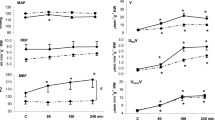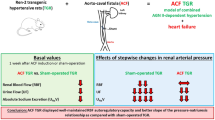Summary
The systemic and renal hemodynamic effects of diltiazem were determined in patients with mild to moderately severe essential hypertension and in rats with spontaneous hypertension (SHR). Seven patients were treated for one full year (300 mg/day, average dose) and 10 SHR and 10 normotensive Wistar-Kyoto (WKY) rats received 1 and 2 mg/ kg, intravenously. In both man and rat with genetic hypertension, arterial pressure was reduced through a fall in total peripheral resistance without associated reflexive increases in heart rate and cardiac index; and the patients demonstrated no change in plasma volume. In both man and the SHR: renal blood flow increased (in SHR not statistically significant) as arterial pressure and renal vascular resistance fell; glomerular filtration rate (GFR) remained unchanged and the filtration fraction (FF) significantly fell; and calculated intrarenal hemodynamic indices (using the Gomez formulae) demonstrated falls in afferent and efferent glomerular arteriolar pressures and resistances and in intraglomerular pressures, thereby explaining the unchanged GFRs and the decline in FF. These findings in both hypertensive man and rat are in contrast with those of the normotensive WKY that only demonstrated a fall in afferent glomerular arteriolar resistance. Thus, these data demonstrate that diltiazem controlled arterial pressure in both forms of genetic hypertension associated with falls in systemic and renal arteriolar resistances and with improved intrarenal hemodynamics without glomerular hyperfiltration.
Similar content being viewed by others
References
Kaplan NM. The role of the kidney in hypertension. The Goldblatt Memorial Lecture, Pt. II. Hypertension 1979;1:456–461.
Hostetter TH, Olson JL, Rennke HG, et al. Hyperfiltration in remnant nephrons: A potentially adverse response to renal ablation. Am J Physiol 1981;241:F85-F93.
Myers BD, Deen WM, Brenner BM. Effects of norepinephrine and angiotensin II on the determinants of glomerular ultrafiltration and proximal tubule fluid reabsorption in the rat. Circ Res 1975;37:101–110.
Amodeo C, Kobrin I, Ventura HO, et al. Immediate and short-term hemodynamic effects of diltiazem in hypertension. Circulation 1986;73:108–113.
Messerli FH, de Carvalho JGR, Christie B, et al. Systemic and regional hemodynamics in low, normal and high cardiac output in borderline hypertension. Circùlation 1978;58:441–448.
Dunn FG, Chandraratna P, de Carvalho JGR, et al. Pathophysiologic assessment of hypertensive heart disease with echocardiography. Am J Cardiol 1977;39:789–795.
Albert NS. Blood volume. In: Blahd WH, ed. Nuclear Medicine. New York: McGraw-Hill, 1971. Pp. 593–619.
Sealey JE, Laragh JH, Gerten-Banes J, et al. The measurement of plasma renin activity in man. In: Laragh JH, ed. Hypertension Manual. New York: York Publishing Company, 1974. Pp. 621–640.
Tan SY, Noth R, Mulrow PJ. Direct non-chromatographic radioimmunoassay of aldosterone: Validation of a commercially available kit and observations on age-related changes in concentrations in plasma. Clin Chem 1978;24:1531–1533.
Peuler JD, Johnson GA. Simultaneous single isotope radioenzymatic assay of plasma norepinephrine, epinephrine and dopamine. Life Sci 1977;21:624–636.
Tsuchiya M, Ferrone RA, Walsh GM, et al. Regional blood flows measured in conscious rats by the combined Fick and microsphere methods. AM J Physiol 1978;235:H357-H360.
Ishise S, Pegram BL, Yamamoto J, et al. Reference sample microsphere method: Cardiac output and blood flows in conscious rats. AM J Physiol 1980;239:H443-H449.
Kobrin I, Pegram Bl, Frohlich ED. Acute pressure increase and intrarenal hemodynamics in conscious WKY and SHR rats. AM J Physiol 1985;249:1114–1118.
Gomez DM. Evaluation of renal resistances with special reference to changes in essential hypertension. J Clin Invest 1951;30:1143–1155.
Hall JE, Coleman TG, Guyton AC, et al. Control of glomerular filtration rate by circulating angiotensin II. Am J Physiol 1981;241:R190-R197.
Landis RM, Pappenheimer JP. Exchange of substances through capillary walls. In: Handbook of Physiology. Washington, D.C.: Am Physiol Soc, 1963;2(2):961–1034.
Snedecor GW, Cochran WG. Statistical methods, 6th ed. Ames, Iowa. Iowa State University Press, 1972.
Miller JG. Simultaneous statistical significance. New York: McGraw-Hill, 1966.
Kinoshita M, Kusukawa R, Shimono Y, et al. Effects of diltiazem on renal hemodynamics and urinary electrolyte excretion. Jpn Circ J 1978;42:553–560.
Bauer JH, Sunderrayan S, Reams G. Effects of calcium entry blockers on renin-angiotensin-aldosterone system, renal function and hemodynamics, salt and water excretion and body fluid composition. Am J Cardiol 1985;56:62H-67H.
Bauer JH, Reams G. Short and long-term effects of calcium entry blockers on the kidney. Am J Cardiol 1987;59:66A-71A.
Loutzenheiser R, Epstein M. Effects of calcium antagonists on renal hemodynamics. An editorial review. Am J Physiol 1985;249:F619-F629.
Azar S, Tobian L, Johnson MA. Glomerular, efferent arteriolar, peritubular capillary, and tubular pressures in hypertension. Am J Physiol 1974;227:1045–1050.
Natsume T, Gallo AJ, Pegram BL, et al. Hemodynamic effects of prolonged treatment with diltiazem in conscious normotensive and spontaneously hypertensive rats. Clin Exper Hyper—Theory and Practice 1985;A7:1471–1479.
Navar LG, Rosivall L. Contribution of the renin-angiotensin system to the control of intrarenal hemodynamics. Kidney Int 1984;25:857–868.
Wright FS. Intrarenal regulation of glomerular filtration rate. J Hypertension 1984;2(Suppl 1):105–113.
Author information
Authors and Affiliations
Rights and permissions
About this article
Cite this article
Isshiki, T., Amodeo, C., Messerli, F.H. et al. Diltiazem maintains renal vasodilation without hyperfiltration in hypertension: Studies in essential hypertensive man and the spontaneously hypertensive rat. Cardiovasc Drug Ther 1, 359–366 (1987). https://doi.org/10.1007/BF02209077
Issue Date:
DOI: https://doi.org/10.1007/BF02209077




